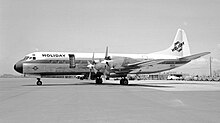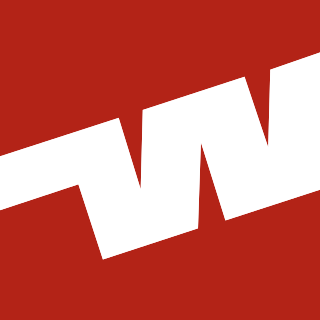
Western Airlines was a major airline in the United States based in California, operating in the Western United States including Alaska and Hawaii, and western Canada, as well as to New York City, Boston, Washington, D.C., and Miami and to Mexico City, London and Nassau. Western had hubs at Los Angeles International Airport, Salt Lake City International Airport, and the former Stapleton International Airport in Denver. Before it merged with Delta Air Lines in 1987 it was headquartered at Los Angeles International Airport (LAX). Throughout the company's history, its slogan was "Western Airlines...The Only Way to Fly!"

Hollywood Burbank Airport, formerly called Bob Hope Airport after entertainer Bob Hope, is a public airport three miles (4.8 km) northwest of downtown Burbank, in Los Angeles County, California, United States. The airport serves Burbank, Hollywood, and the northern Greater Los Angeles area, which includes Glendale, Pasadena, the San Fernando Valley and the Santa Clarita Valley. It is closer to many popular attractions, including Griffith Park, Universal Studios Hollywood, and Downtown Los Angeles, than Los Angeles International Airport (LAX), and it is the only airport in the area with a direct rail connection to Downtown Los Angeles, with service from two stations: Burbank Airport–North and Burbank Airport–South. Nonstop flights mostly serve cities in the western United States, though JetBlue has daily flights to New York City. Southwest also occasionally flies non regular routes to the East Coast.
Pacific Southwest Airlines (PSA) was a low-cost US airline headquartered in San Diego, California, that operated from 1949 to 1988. It was the first substantial scheduled discount airline. PSA called itself "The World's Friendliest Airline" and painted a smile on the nose of its airplanes, the PSA Grinningbirds. Opinion L.A. of the Los Angeles Times called PSA "practically the unofficial flag carrier airline of California for almost forty years."
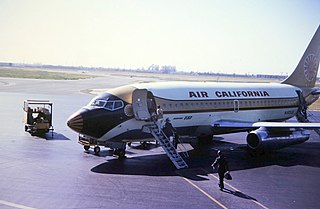
Air California, later renamed AirCal, was a U.S. airline company headquartered in Newport Beach, California that started in the 1960s as a California intrastate airline. The airline's home airport was Orange County Airport, now known as John Wayne Airport.

Golden West Airlines was a commuter airline that operated flights on a high volume schedule in California. It ceased operations in 1983.

Imperial County Airport is a county-owned public-use airport in Imperial County, California, United States. Also known as Boley Field, it is mostly used for general aviation, but has scheduled passenger service from one commercial airline. Service is subsidized by the Essential Air Service program.

General William J. Fox Airfield is a county-owned, public airport in Los Angeles County, California, five miles northwest of Lancaster, California, United States. Locally known as Fox Field, the airport serves the Antelope Valley. The airport is named after Brigadier General William J. Fox, "a Marine war hero, a movie stunt man, the first Los Angeles County engineer and, for 20 years after his retirement, a cowboy."
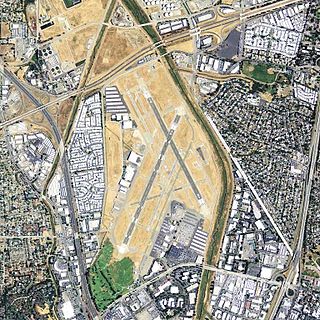
Buchanan Field Airport is a medium-sized general and business public airport in Contra Costa County, California, United States, one mile west of the center of Concord and just east of Pacheco in the San Francisco Bay Area. The airport's street address is 550 Sally Ride Drive, Concord.

The California Public Utilities Commission is a regulatory agency that regulates privately owned public utilities in the state of California, including electric power, telecommunications, natural gas and water companies. In addition, the CPUC regulates common carriers, including household goods movers, limousines, rideshare services, self-driving cars, and rail crossing safety. The CPUC has headquarters in the Civic Center district of San Francisco, and field offices in Los Angeles and Sacramento.
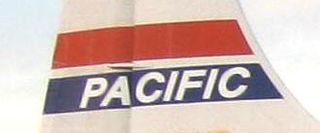
Pacific Air Lines was a regional airline on the West Coast of the United States that began scheduled passenger flights in the mid-1940s under the name Southwest Airways. The company linked small cities in California with larger cities such as Los Angeles and San Francisco. Flights later operated to Portland, Oregon, and eventually reached Las Vegas and Reno in Nevada.

Eastern Sierra Regional Airport is two miles east of Bishop, in Inyo County, California, United States. It is owned by the City of Los Angeles, Department of Public Works and operated by Inyo County.

Mammoth Yosemite Airport is a town-owned public airport seven miles east of Mammoth Lakes, in Mono County, California, United States. Also known as Mammoth Lakes Airport or Mammoth–June Lake Airport, it is mainly used for general aviation, but has scheduled passenger flights operated by one airline which primarily serves the airport on a seasonal basis during the winter ski season. Additional scheduled passenger service for the Mammoth area is seasonally available at the nearby Eastern Sierra Regional Airport located in Bishop, CA.
National Airlines was a major airline in the United States that operated from 1934 to 1980, when it merged with Pan Am. For most of its existence the company was headquartered at Miami International Airport, Florida. At its height, National Airlines had a network of "Coast-to-Coast-to-Coast" flights, linking Florida and Gulf Coast destinations such as New Orleans and Houston with cities along the East Coast as far north as Boston as well as with large cities on the West Coast including Los Angeles, San Francisco and Seattle. From 1970 to 1978, National, Braniff International Airways, Pan American World Airways and Trans World Airlines (TWA) were the only U.S. airlines permitted to operate scheduled passenger flights to Europe.
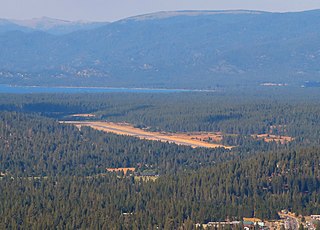
Lake Tahoe Airport is a public airport three miles southwest of South Lake Tahoe, in El Dorado County, California. It covers 348 acres (141 ha) and has one runway; it is sometimes called Tahoe Valley Airport. Although the airport had almost forty years of airline service, since 2000, it has served only general aviation.
Air Bahia was an airline with flights to Mexico which also served Las Vegas and Tucson during its existence.

Air Pacific was a commuter airline based in the United States that operated regional flights wholly within the state of California. Founded as Eureka Aero in 1970, it was renamed Air Pacific in 1979. Its de Havilland Canada DHC-6 Twin Otter and DHC-7 Dash 7 turboprop aircraft were capable of STOL operations.
Wings West Airlines was an American regional airline headquartered at McChesney Field (SBP), unincorporated San Luis Obispo County, California. The airline initially began scheduled passenger service as an independent commuter air carrier and then subsequently became an American Eagle affiliate of American Airlines operating turboprop aircraft on code sharing flights on behalf of American.

California Central Airlines (CCA) was a post-war American scheduled price-focused intrastate airline based at Burbank, California, the most prominent airline associated with Charles C. Sherman. CCA slightly preceded, and during its existence was bigger than, its contemporary and competitor, Pacific Southwest Airlines (PSA). The core route of both airlines was from Los Angeles to the San Francisco Bay Area.

Intrastate airlines in the United States were air carriers operating solely within a single US state and taking other steps to minimize participation in interstate commerce, thus enabling them to escape tight Federal economic airline regulation prior to US airline deregulation in 1979. These intrastate carriers therefore amounted to a small unregulated, or less regulated, sector within what was otherwise then a tightly regulated industry. Geography alone did not determine intrastate status.
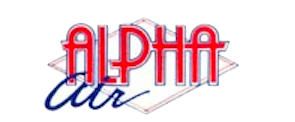
Alpha Air is a defunct regional airline based in Los Angeles.
